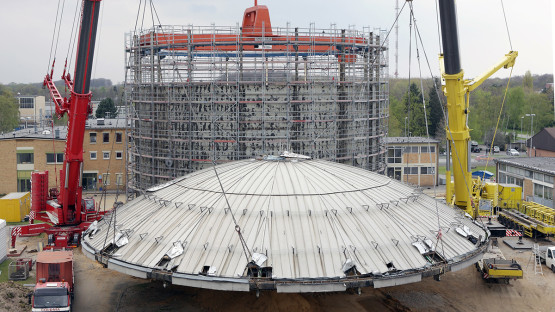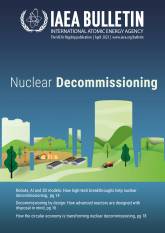
If you would like to learn more about the IAEA’s work, sign up for our weekly updates containing our most important news, multimedia and more.
A new business model for decommissioning nuclear power plant
Bruce A. Watson

As a long-standing pioneer of nuclear technology, the USA now operates one of the world’s oldest and largest nuclear power programmes. As fleets of reactors age out of service, increasingly large numbers of decommissioning projects are being created. Currently, the NRC oversees 17 nuclear power plants (NPPs) that are in active decommissioning, and eight NPPs in safe storage, as well as the decommissioning of two research reactors and several other nuclear sites. In addition, several defence-related sites that fall under the regulatory powers of the Department of Energy are also being decommissioned. This demand is driving innovation, with companies finding creative ways of meeting this challenge.
In 2010, a completely new business model for decommissioning emerged in the USA. Prior to this, all decommissioning projects involving NRC-licensed reactors used a similar business model. The operator of the NPP continued to hold full responsibility for the duration of the decommissioning process. The operators would either choose to implement all decommissioning work themselves or contract a company to do the work for them. In the early 1990s, ten NRC-licensed reactors were shut down and their decommissioning was completed by 2009, all using this traditional model.
However, by the end of 2010, lengthy discussions between decommissioning companies and operators had borne fruit and opened the field for a new way of carrying out decommissioning projects. In the first instance, a US operator agreed to transfer a temporary licence to a decommissioning company. After decommissioning had been completed, the licence for the land and the spent fuel dry storage facility would transfer back to the original operator. The NRC approved this, and also approved a similar process between another operator and a decommissioning company shortly afterwards.
Opportunities and challenges
These agreements materialized only after years of negotiations. The prospective licensees had to weigh up both the opportunities and the challenges thoroughly. On the one hand, such a licence transfer would provide the decommissioning company with full access to the NPP’s decommissioning trust fund. On the other hand, they would also become fully responsible and liable for all financial and regulatory risks resulting from the operation. Ultimately, the deals went ahead despite these risks. Three years later, in 2013, the first companies agreed to a permanent, rather than temporary, licence transfer as part of the sale of the facility.
In many ways, 2013 was a landmark year. It was the first time a decommissioning company spoke to the operator of an NPP that was about to shut down and offered to buy the plant in order to decommission it. A sales agreement was then negotiated for an NPP that shut down that year. The operator and the decommissioning company applied to transfer the licence permanently to the decommissioning company.
Decommissioning companies that acquired such licences could often integrate these activities into their established businesses, as they might already operate nuclear waste disposal sites or be certified to provide spent fuel storage services.
Significant acceleration in planning timelines
One remarkable result of this 2013 licensing transfer was a significant acceleration in the planning timelines for decommissioning activities. The plant’s licence termination was initially planned for 2073. This meant that, originally, the operator would take advantage of the NRC regulations that require that the licence termination be completed in 60 years. For licence termination, the plant had to be fully decommissioned, including the environmental remediation of the land, which would enable it to be repurposed for other uses. A new licensee plans to finish the same process by 2030, with the spent fuel dry storage facility remaining a licensed and inspected facility.
Some other operators whose older NPPs in safe storage are nearing a 2030 decommissioning deadline might also want to consider such a licence transfer to switch to a more accelerated process. One important consideration is that, in the USA, an NPP must be decommissioned and the licence terminated within 60 years of ceasing operations.
Licence transfers have now become quite common in the USA and apply to a significant number of NPPs being decommissioned. Nonetheless, the traditional business model of operators continuing with plant decommissioning persists and still provides the basis for many ongoing decommissioning projects.
Also, it quite unlikely that other countries will be inspired to follow the USA’s model for decommissioning. The main reason is that, in contrast to most other countries, US NPPs are commercially independent. As a result, the US business model is different from most other countries.
Speed up similar projects around the world
However, the accelerated decommissioning processes that are being implemented in the USA could help to speed up similar projects around the world. We share our lessons learned with other countries, which is enabled by international organizations and through IAEA safety standards, workshops, forums, missions and publications. The IAEA does essential work to promote consistency in how decommissioning is conducted, ensuring that it is implemented safely and carried out within solid regulatory frameworks.
The IAEA plays an important role in providing information on consistent approaches to decommissioning, such as dose limits, to ensure that there is wide agreement on when a site is successfully cleaned up and enhance safety for local communities. The IAEA’s documents are highly useful in this area. There is a real thirst for knowledge across the international community in the decommissioning sector on how to perform decommissioning safely and effectively.
_______________________________________________
Bruce A. Watson is the Special Assistant in the Division of Decommissioning Uranium Recovery and Waste Programs in the Office of Nuclear Material Safety and Safeguards at the United States Nuclear Regulatory Commission (NRC). A former nuclear operator, he gathered extensive experience in decommissioning reactors and materials at sites as the technical lead for the licence termination of United States (US) nuclear power reactors. Bruce also has extensive international decommissioning experience with the IAEA, helping to develop decommissioning Safety Guides and training programmes. He has served as an expert on several IAEA peer review and advisory missions.

